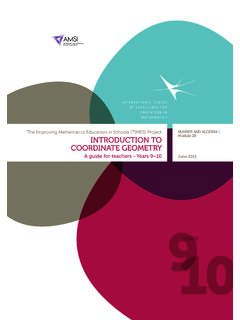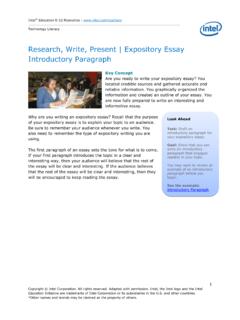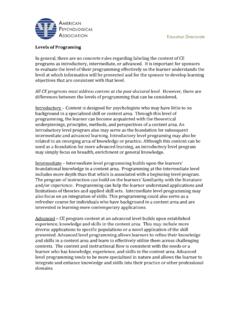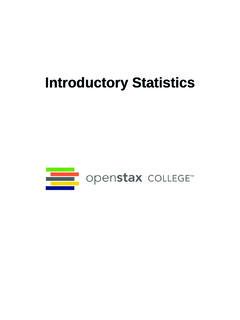Transcription of MEASUREMENT AND INTRODUCTORY TRIGONOMETRY
1 INTRODUCTORY TRIGONOMETRY MEASUREMENT AND GEOMETRY Module 23A guide for teachers - Years 9 10 The Improving Mathematics Education in Schools (TIMES) Project June 2011 IININTROI ntroductory TRIGONOMETRY ( MEASUREMENT and Geometry: Module 23)For teachers of Primary and Secondary Mathematics510 Cover design, Layout design and Typesetting by Claire HoThe Improving Mathematics Education in Schools (TIMES) Project 2009 2011 was funded by the Australian Government Department of Education, Employment and Workplace views expressed here are those of the author and do not necessarily represent the views of the Australian Government Department of Education, Employment and Workplace The University of Melbourne on behalf of the international Centre of Excellence for Education in Mathematics (ICE EM), the education division of the Australian Mathematical Sciences Institute (AMSI), 2010 (except where otherwise indicated).
2 This work is licensed under the Creative Commons Attribution NonCommercial NoDerivs Unported License. nc BrownMichael EvansDavid HuntJanine McIntoshBill PenderJacqui RamaggeIntrodnInucytu yTniIncdgy Module 23 INTRODUCTORY TRIGONOMETRYThe Improving Mathematics Education in Schools (TIMES) Project June 2011A guide for teachers - Years 9 10910 YEARSINTRODUCTORY TRIGONOMETRY {4}A guide for teachersASSUMED KNOWLEDGE Familiarity with Pythagoras theorem. Basic knowledge of congruence and similarity of triangles. Knowledge of the basic properties of triangles, squares and rectangles. Facility with simple algebra and equations. Familiarity with the use of a word TRIGONOMETRY signifies the MEASUREMENT of triangles and is concerned with the study of the relationships between the sides and angles in a triangle.
3 We initially restrict our attention to right angled triangles. TRIGONOMETRY was originally developed to solve problems related to astronomy, but soon found applications to navigation and a wide range of other areas. It is of great practical importance to builders, architects, surveyors and engineers and has many other applications. Suppose we lean a ladder against a vertical wall. By moving the ladder closer to the wall, thereby increasing the angle between the ladder and the ground, we increase the distance up the wall that the ladder can reach. Since the length of the ladder remains the same, Pythagoras theorem relates the distance up the wall to the distance of the ladder from the base of the wall. TRIGONOMETRY allows us to relate that same distance to the angle between the ladder and the ground.
4 {5}The Improving Mathematics Education in Schools (TIMES) ProjectTo measure the height of a flagpole, an observer can measure a distance out from the base and the angle made between the top of the pole and observer s eye as shown in the of flagpoleAs with many topics in Mathematics, TRIGONOMETRY is a subject which continues on into the senior years of secondary school and well beyond into higher mathematics. Modern telecommunications depend on an understanding and harnessing of signal processing, which is modelled by the trigonometric functions. Each right angled triangle contains a right angle. The congruence tests tell us that if either of the following pieces of information is known, then the triangle is completely determined: one other angle and one side (by the ASA congruence test) two sides (by either the SAS test or the RHS test).
5 TRIGONOMETRY and Pythagoras theorem enable us to find the remaining sides and angles in both cases.{6}A guide for teachersCONTENTIf we have two similar right angled triangles (sometimes called right triangles), then the angles of one match up with the angles of the other and their matching sides are in the same example, the following triangles are B C 1086 Since the matching sides are in the same ratio, BCB C = ABA B = means that the ratio BCAB = B C A B = 810 = , the ratioACAB = A C A B = 610 = 35 andBCAC = B C A C = 86 = is, once the angles of a triangle are fixed, the ratios of the sides of the triangle are constant. In a right angled triangle, we only need to know one other angle and then the angle sum of a triangle gives us the third angle.
6 Hence, in a right angled triangle, if we know one other angle, then the ratios of the sides of the triangle are is the basis of TRIGONOMETRY .{7}The Improving Mathematics Education in Schools (TIMES) ProjectEXERCISE 1 Draw up an angle of 58 using a protractor. Place markers at distances of 3cm, 5cm and 8cm and draw perpendiculars as shown in the 83Oh1h2h3 Measure the heights marked, h1, h2, h3 and calculate to one decimal place the ratios h13, h25, are the ratios (approximately) equal ?Naming the sidesIn order to distinguish the various possible ratios in a right angled triangle, we introduce some names. We always refer to the longest side (opposite the right angle) as the now choose one of the two acute angles and label it, often using one of the Greek letters a, , g or.
7 We shall call this angle the reference side opposite the reference angle is called the opposite side, generally referred to as the opposite, and the remaining side is called the adjacent side, or simply adjacent, since it is next to the reference angle. ABhypotenuseoppositeadjacentC{8}A guide for teachersTHE TANGENT RATIOAs mentioned above, once we fix the size of the reference angle in a right angled triangle then the ratios of various sides remain the same irrespective of the size of the triangle. There are six possible trigonometric ratios we could use. We mainly work with just three of them. The remaining three are their ratio of the opposite to the adjacent is known as the tangent ratio or the tangent of the angle . (The name comes from an earlier time and involves the use of circles.)
8 We writetan = oppositeadjacent where0 < < 90 .oppositeadjacentEXAMPLEW rite down the value of tan .a 40941 b 262410 SOLUTION atan = 409btan = 2410= 125 EXERCISE 2By drawing an appropriate triangle explain why tan 45 = 1 From the first exercise above, you will have found that the ratios h13, h25, h38 were all approximately These ratios correspond to a tangent ratio, so tan 58 is approximately The calculator gives tan 58 tangent ratio for other angles can be found using a calculator. Needless to say the calculator does not draw a triangle but uses clever mathematical algorithms to find the value. It is important that students make sure their calculator is in degree mode. We can use the tangent ratio to calculate missing sides in a right angled triangle, provided we are given the right information.
9 {9}The Improving Mathematics Education in Schools (TIMES) ProjectEXAMPLEaFind the length marked x in the diagram below, correct to two decimal x cm13cmbFind x, correct to two decimal places43 x cm11cm SOLUTION atan 33 = x13btan 43 = 11xHencex = 13 tan 33 Hencex tan 43 = 11 = 11tan 43 THREE BASIC TRIGONOMETRIC RATIOSIn addition to the tangent ratio, there are two other basic ratios that we use. These are known as the sine and cosine ratios. We take to be the reference angle so 0 < < 90 . The three ratios are defined by: sin = oppositehypotenuse, cos = adjacenthypotenuse, tan = oppositeadjacentStudents need to learn these definitions thoroughly. One simple mnemonic that might assist them is SOH CAH TOA, consisting of the first letter of each ratio and the first letter of the sides making up that ratio.
10 EXAMPLEFor the following triangle, write down the value of:asin bcos ctan SOLUTION asin = oppositehypotenusebcos = adjacenthypotenusectan = oppositeadjacent = 1026 = 2426 = 1024 = 513 = 1213 = 51210cm26cm24cm{10}A guide for teachersSPECIAL ANGLESThe angles 30 , 45 and 60 appear frequently in TRIGONOMETRY and their sine, cosine and tangent ratios can be expressed using rational numbers and 3In the diagrams below, calculate all sides and angles and then fill in the table 30 45 60 sin cos tan We can use the trigonometric ratios to calculate missing sides in a right angled the value of x, correct to four decimal 25 x cm12cm b 16 x cm9cmc 35 x cm8cm{11}The Improving Mathematics Education in Schools (TIMES) ProjectSOLUTIONaThis problem involves opposite and hypotenuse, so use problem involves adjacent and hypotenuse, so use 25 = 12xxsin 25 = 12x= 12sin 25 16 = 9xx cos 16 = 9x= 9cos 16 problem involves adjacent and opposite, so use 35 = 8xor x tan 35 = 8x= 8tan 35 tan 55 (55 is the complement of 35 )x = tan 55 55 x cm8cmEXERCISE 4 Suppose that 0 < < 90.












